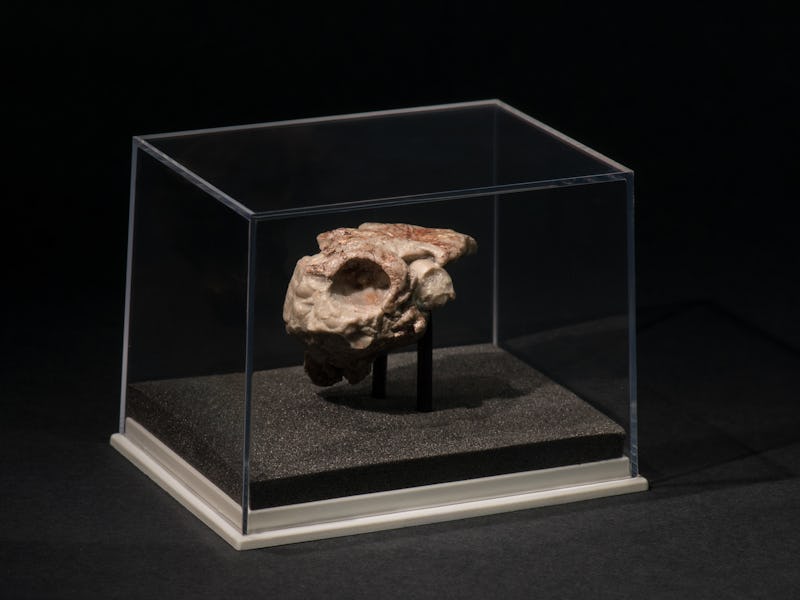400-million-year-old fish reveals new clues to how humans got teeth
"Nobody expected to find teeth so deep on the evolutionary tree."

The story of how vertebrates got their teeth is much older than researchers realized, new findings show.
In a paper published Thursday in the journal Science, scientists examined the teeth of three different ancient armored fish genera, dating back to the Devonian period. Their novel analysis suggests that the evolution of specialized teeth happened much earlier than expected, some 400 million years ago.
The very first vertebrates were jawless, similar to the hagfish. While we have that knowledge, there's been little understanding of when teeth began to evolve — although some previous studies have hinted that the Devonian period was important for tooth evolution.
Teeth were previously discovered in a group of ancient armored fish called arthrodires, which are ancestors of jawed vertebrates. Those teeth were considered to be advanced, so "it was naturally expected that if any teeth are found in more primitive jawed vertebrates they would naturally have to be comparable to arthrodire teeth or simpler," explains Valéria Vaškaninová, the study's first author and a paleontologist at Uppsala University in Sweden.
But in an unexpected discovery, Vaškaninová and her team found surprisingly modern teeth in fish even more primitive than arthrodires — fish called acanthothoracids. The new study uses synchrotron microtomography to capture the dentition, or arrangement of teeth, in three arthrodire-like genera: Radotina, Kosoraspis, and Tlamaspis.
(A separate 2015 paper originally posited that Radotina developed a tooth plate — but that discovery turned out to actually be a scalelike dermal bone plate, a feature also found in many early vertebrates, including jawless fish.)
Complex evolution — Researchers weren't sure exactly when, in the course of evolution, the first teeth appeared.
But it stood to reason that, since arthrodires were considered to be the root of tooth evolution, the three more primitive genera would have more simpler teeth. That turned out not to be the case; the animals instead to have specialized dentition, used for hunting prey.
The teeth on Radotina seem to be adapted for cutting, while those of Kosoraspis and Tlamaspis would work well for different styles of grasping-piercing, Vaškaninová says.
The dentition suggests a step in evolution between primitive fish and modern fish, which have jaws.
Skull of a primitive jawed vertebrate.
Vaškaninová explains that her team had some idea to what teeth in the common ancestor between cartilaginous fish — sharks, rays, and skates — and bony fish would look like. But they hadn't yet seen that dentition in acanthothoracids.
"What was most exciting about our discovery was that we found teeth and dermal jawbones with shared characters from both groups," Vaškaninová tells Inverse.
A 400 million year old tropical reef.
As it turns out, arthrodire dental plates look very different from modern fish jaws. Scientists couldn't figure out how they eventually developed to look as they do today. The new study on acanthothoracids fills in that gap.
"Nobody expected to find teeth so deep on the evolutionary tree and definitely not with such 'modern' characters," Vaškaninová says.
The teeth are more similar to the dentitions of bony fish — suggesting that sharks and shark relatives are more specialized, rather than primitive, in their tooth arrangement. Acanthothoracids have specialized arrangements too, as do humans.
"So even we, humans, can trace our teeth and jawbones directly from the very first jawed vertebrates," Vaškaninová says.
Abstract: The dentitions of extant fishes and land vertebrates vary in both pattern and type of tooth replacement. It has been argued that the common ancestral condition likely resembles the nonmarginal, radially arranged tooth files of arthrodires, an early group of armoured fishes. We used synchrotron microtomography to describe the fossil dentitions of so-called acanthothoracids, the most phylogenetically basal jawed vertebrates with teeth, belonging to the genera Radotina, Kosoraspis, and Tlamaspis (from the Early Devonian of the Czech Republic). Their dentitions differ fundamentally from those of arthrodires; they are marginal, carried by a cheekbone or a series of short dermal bones along the jaw edges, and teeth are added lingually as is the case in many chondrichthyans (cartilaginous fishes) and osteichthyans (bony fishes and tetrapods). We propose these characteristics as ancestral for all jawed vertebrates.
This article was originally published on